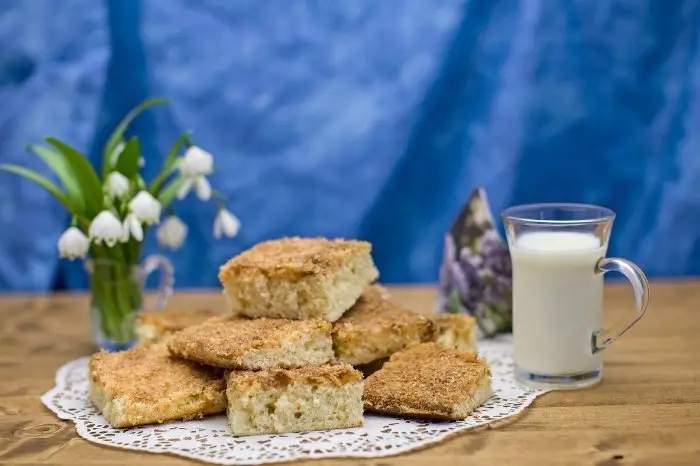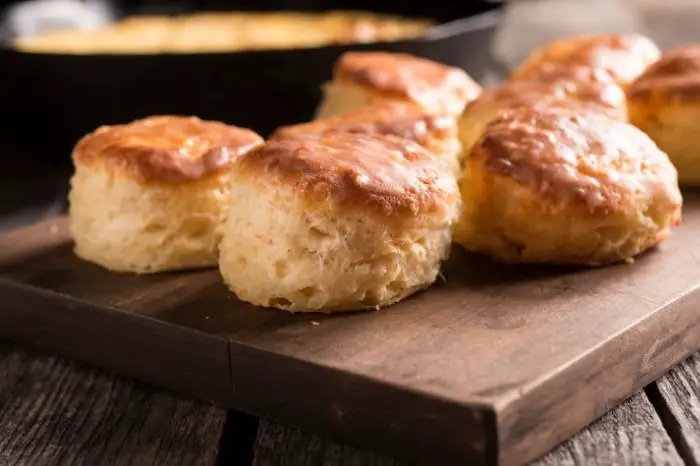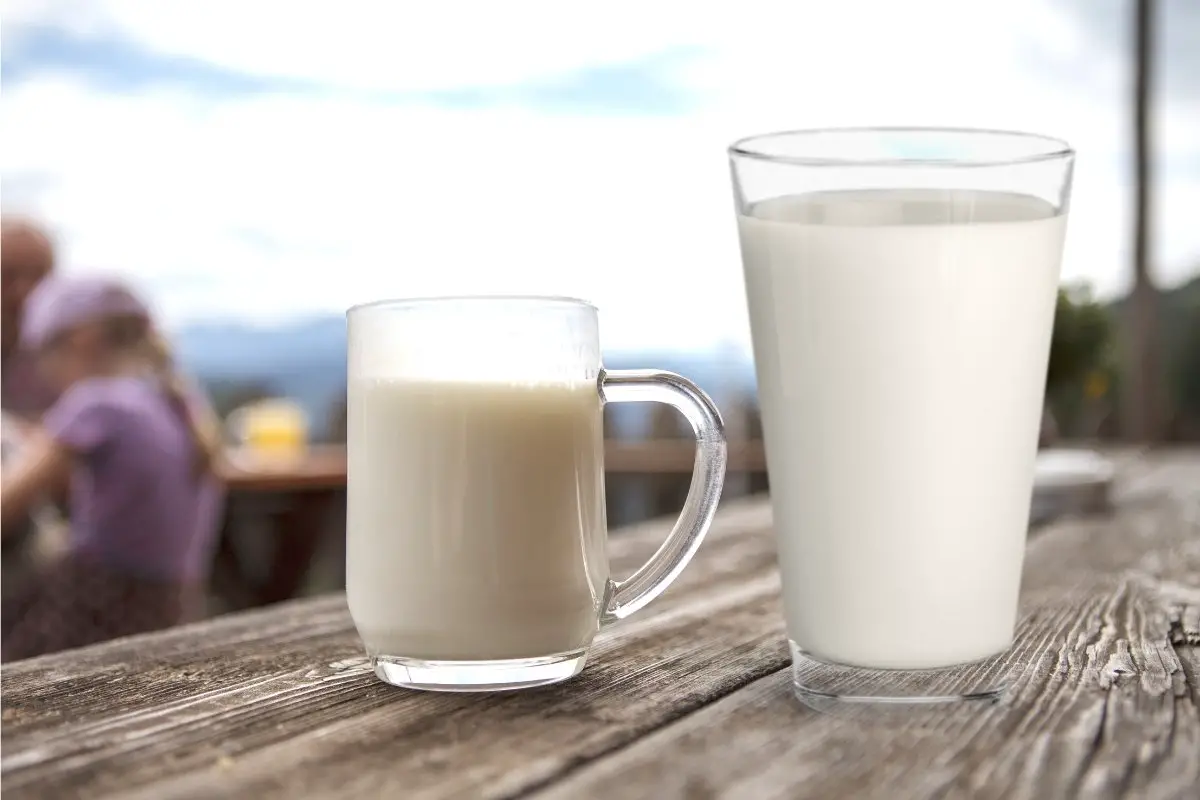Last Updated on August 26, 2021
If you are an avid baker, you will want to know the differences between buttermilk vs milk in cake. Both buttermilk and milk are common ingredients in cakes and other baked goods. Though they are similar, they have their differences as well.
Though in some cases buttermilk and milk can be substituted for each other, oftentimes they can’t be. Each one does a specific thing in baking that is key to achieving a moist and flavorful cake. They are both important ingredients in recipes.
Buttermilk vs Milk in Baking
Both milk and buttermilk work to provide moisture and flavor in cakes. Though they are both dairy products, they differ slightly.
Originally, buttermilk was the leftover liquid from the process of churning butter. Today, buttermilk is typically made in an industrial fashion that is similar to how yogurt is produced. Buttermilk is slightly thicker than milk and has a tangier flavor.
To make buttermilk, milk is pasteurized and homogenized. Then, it is inoculated with a culture of Lactococcus lactis or Lactobacillus bulgaricus along with Leuconostoc citrovorum. This is done in order to simulate the bacteria that naturally occurs in authentic buttermilk.

Many cake recipes will call for either buttermilk or milk. Oftentimes, if a recipe calls for milk, it will either be whole milk or 2% milk. In addition to milk, some recipes will also call for sour cream which adds flavor and brings acidity.
When it comes to baking, milk gives the cake a slightly darker color as well as a slightly coarser texture. Milk often provides a subtler flavor in the cake as well. The lower the fat content of milk, the less tender it will be, so it is best to avoid 1% and skim milk when baking.
Whole milk has nine grams of fat in one serving and an acidity level of .14%. Buttermilk, on the other hand, has 2.5 grams of fat per serving with an acidity level of 1%.
When using buttermilk or milk in a recipe, both should be brought to room temperature before adding. If they are cold when you add them to your ingredients, this can mess up the texture of your cake.
What Does Buttermilk do to Cake?
Due to the acidity of buttermilk, it gives cakes a more tender crumb and lighter texture. In addition, buttermilk adds a mild complexity that is not too tangy to the cake.
Hoosier Hill Farm Buttermilk Powder, 1 Pound
Both buttermilk and milk will give the cake a moist texture. Depending on who you ask, some people may prefer to use one over the other. However, it is always best to stick with whatever the recipe you are making calls for.
Once opened, buttermilk can last up to 14 days. Whole milk, on the other hand, lasts only four to seven days once opened.
Common Uses for Buttermilk
In addition to cake, buttermilk is used in many other recipes. Popular buttermilk recipes include buttermilk waffles, buttermilk pancakes, and buttermilk biscuits. In addition, it is also used for marinades for chicken and even ranch dressing.
Though it is not very common, some people will drink buttermilk straight from the carton. However, if you are having a hard time using your buttermilk up before the exploration date, you can freeze it as well.
Pour your buttermilk into an ice cube tray and then allow it to freeze. Once frozen, transfer the cubes of buttermilk into a Ziploc bag or an airtight container.

The buttermilk can last in the freezer for up to three months. Once you are ready to use some, allow them to thaw overnight in the fridge.
Looking for Delicious Recipes, Click Here:
Substitute Buttermilk for Milk
If you are in a pinch, you can substitute buttermilk for milk. However, there will likely be a slight change in the flavor and texture of the cake. When possible, it is always best to use what the recipe calls for.
Buttermilk can be found in grocery stores in the dairy section. It is often sold in half pints, quarts, and half gallons.
If you don’t have buttermilk, you can easily make your own at home to use. To make your own buttermilk add one tablespoon of lemon juice or vinegar to a measuring cup. Then, fill the measuring cup to the one cup line with milk.
Carefully mix together the milk and lemon juice or vinegar to form buttermilk. Allow the mixture to sit for five minutes before using it for your recipe. Adding the lemon juice or vinegar gives the milk the acidity it needs to equate to buttermilk.
If you don’t have storebought buttermilk on hand, making your own is the next best thing. It is simple to do and will generally work just as well as real buttermilk in your recipe. For best results, be sure to use whole milk when making your own buttermilk.
It is important to note that storebought buttermilk is thicker, tangier, and more acidic than the homemade version. So, if you do a lot of baking, storebought will be your best option for the best results.
Key Ingredients for Your Favorite Recipes: Buttermilk vs Milk in Cake
Both buttermilk and milk are key ingredients in recipes, especially cake. Though both provide moisture and flavor, they do different things when added to cakes. Since they do have their differences, it is always best to stick with what your recipe calls for.
Milk provides cake with a slightly darker color and a texture that is a bit more coarse. Buttermilk provides cake with a more tender texture and a slightly lighter texture. In addition, it also provides a mild flavor complexity while not being too tangy.
Most bakers will keep both milk and buttermilk on hand, as they both serve specific roles. However, buttermilk can easily be made at home if needed by combining milk with lemon juice or vinegar. Though it is not quite the same as storebought, it will often do the trick and work just fine in your cake recipes.
Do you have any questions about buttermilk vs milk in cake? If so, please ask any of your cake questions regarding these two ingredients in the comment section down below.

Ever since she was a young girl, Anna has been a lover of desserts. As an adult, she enjoys
baking a variety of desserts from cakes, cookies, brownies, bread, and more from scratch. She
enjoys sharing her passion for baking with others who also have a sweet tooth. From properly
measuring ingredients to making sure they are the correct temperature, Anna knows the
importance small details can make in baking. She wants to share her experience with others in
hopes they can make the most delicious baked goods. When she’s not busy blogging, Anna
enjoys trying new recipes in the kitchen.


